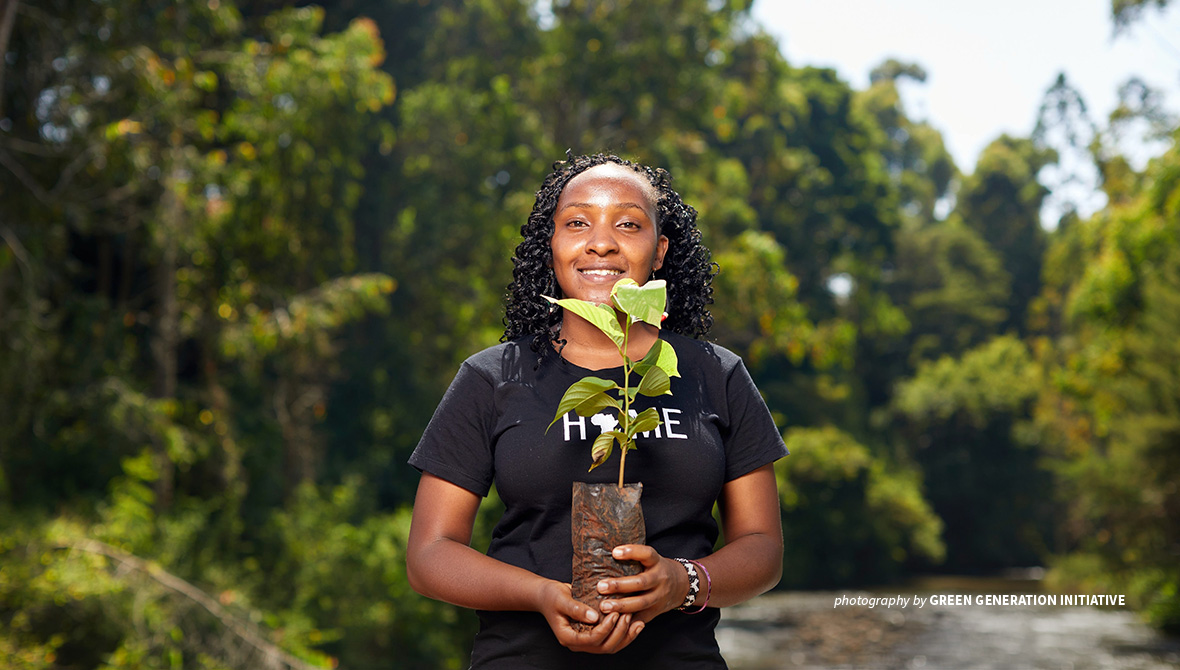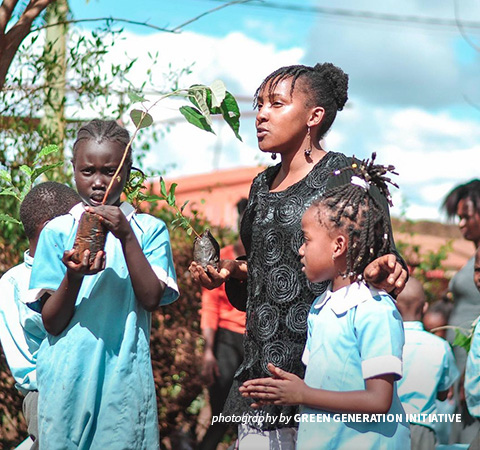Kenyan climate activist shows how nature photography sparks change

Seven-year-old Elizabeth Wathuti planted her first tree in her hometown of Nyeri, Kenya and launched her journey in conservation. In 2016, she received the Wangari Maathai Scholarship Award and attained a degree in environmental studies and community development. As a university student, she founded the Green Generation Initiative, a community-based organization running environmental education, tree growing, greening schools, and waste management programs for young learners across Kenya. Apart from representing the country at the U.N. Climate Conference (also known as COP 26) this year, Wathuti serves as the Global South Co-Chair of the COP 26 Civil Society and Youth Advisory Council. She is also the Head of Campaigns at Wangari Maathai Foundation and coordinates Daima, a coalition of civic actors who have come together to advocate for the protection of urban green spaces in Kenya.
As a young member of an esteemed judging panel of nature photographers and conservationists for the inaugural Benjamin Mkapa African Wildlife Photography Awards, Wathuti reflects on how the medium of nature photography moves the needle.
How has nature photography contributed to your work in conservation?
Even though I am not a professional photographer, my social media platforms contain images of natural landscapes and wildlife that have inspired me, as well as photos of me out in nature, spending time, for example, cycling in Karura Forest or in a national park with wildlife, or somewhere with communities who are working to conserve the environment. Being an environmentalist and a climate activist, these photos speak volumes about my passion and the commitment they represent.
Judging the Benjamin Mkapa African Wildlife Photography Awards was a very special experience for me. I thank African Wildlife Foundation for inviting me to join the panel as a youth judge as I was greatly inspired to see Africa's stories being told through the submissions we reviewed. The photographs that really caught my eye captured a moment in the wild that you would not believe until you see it in the image. Another very important element for me is the fact that they are not just images; they have stories behind them — stories of resilience, stories of how conservation is taking place in Africa, and how communities also have continued to influence these efforts.
How has the role of youth in conservation changed over the years?
Young people today are more vibrant than ever before, and a major shift is that youth are no longer waiting to be given a seat at the table. They are on the front line, stepping up action and pushing leaders to take more urgent action. Beyond using their voices for change, young people in communities across the world are taking up leadership roles in implementing nature-based solutions to address the climate crisis, the most challenging issue of our time.
Most of my childhood memories are of time spent out in the forest, close to clean streams. But this natural world that my friends and I knew as children is changing before our eyes. We are now experiencing ecological grief, seeing trees we planted as kids turning into logs and stumps. My fight as an environmentalist and a climate activist is personal because it embodies how I feel the pain of nature caused by environmental degradation.
Seeing these shifts first hand pushed me to the front line; I wanted to be counted among the generation that did everything in their power to stop the climate and the ecological crisis. It was purely out of this passion that I studied environmental studies and community development at Kenyatta University.

Elizabeth Wathuti founded Green Generation Initiative which facilitates tree planting at schools in Kenya
What is the biggest lesson you have taken away from the life and work of Wangari Maathai?
I remember when I planted my first tree at the age of seven, the late Professor Wangari Maathai was the Member of Parliament of Nyeri, my home region. There were many instances of women planting trees and establishing tree nurseries, as well as tree planting activities at schools — these opportunities were a seed planted in me and fueled my passion for conservation to date. It is also the driving force behind the campaigns I head at the Wangari Maathai Foundation, established to instill the late Professor Wangari Maathai's character traits into young people and keep her legacy alive.
How can visual storytelling and photography inspire youth to become conservationists?
Photography can inspire young people to take action because an image encapsulates a real story rather than a theory. For example, much of the information about nature destruction is theoretical; reading about it is different from seeing it actually happen. Photography, as a form of visual storytelling, can bridge the gap, allowing people that live in places that are not deforested to see the impact of forest loss. For those who not able to see critically endangered species like the mountain gorilla in the flesh, photography provides an avenue to communicate effectively.
Similarly, without photography, we are unable to tell the real stories of success. In fact, young people can use nature and wildlife photography to amplify stories of conservation success, spreading hope to counter the of despair of the climate crisis. They can show stories of resilience of the communities who have teamed together and play an active role in conservation. When we tell the real stories of impact, it is going to be easier for us to begin to spark change because we are connecting with people in a more personal and human way so they can relate to what is happening. Ultimately, through photography, climate change becomes a social issue.
What do you think makes a powerful photo that can create change?
A powerful photo is one that speaks to me and teaches me. It should inspire me to do more, be more. Engaging with an image must trigger me to change my lifestyle, alert me about an endangered wildlife species, or expose me to a place of ecological concern. By tapping into the power of photography, we can start important conversations and influence change.
Nature photography is not just about viewing wildlife or breathtaking natural spaces — I want to ask myself, why did the photographer take this photo, what is in their mind? The next question is what lessons can I learn from this image? For the Benjamin Mkapa African Wildlife Photography Awards, I am eager for the announcement of winners on October 28, 2021 and the exhibition so their work can be recognized and more people can think deeper around what the images portray and discover the marvelous stories behind them.
> Learn more about the inaugural Benjamin Mkapa African Wildlife Photography Awards